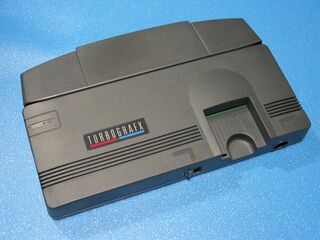Difference between revisions of "TurboGrafx"
From NEC Retro
| (2 intermediate revisions by the same user not shown) | |||
| Line 11: | Line 11: | ||
| releases={{releasesTG16 | | releases={{releasesTG16 | ||
| tg16_date_uk=199x | | tg16_date_uk=199x | ||
| + | | tg16_code_uk=HES-TGX-11 | ||
| + | | tg16_rrp_uk=199.95 {{fileref|CVG UK 090.pdf|page=110}} | ||
| + | | tg16_date_uk_1=199x | ||
| + | | tg16_rrp_uk_1=224.95 {{fileref|CVG UK 090.pdf|page=110}} | ||
| + | | tg16_type_uk_1=Non-SCART | ||
| tg16_date_es=199x | | tg16_date_es=199x | ||
| + | | tg16_code_es=HES-TGX-11 | ||
}} | }} | ||
}} | }} | ||
{{sub-stub}} | {{sub-stub}} | ||
| − | The '''TurboGrafx''' is the European variant of the | + | The '''TurboGrafx''' is the European variant of the [[TurboGrafx-16]]. |
| − | After the US release of the [[TurboGrafx-16]], [[NEC]] got cold feet upon seeing the sales numbers and decided to cancel their planned European releases. All of the stock planned for release in Europe - US systems | + | After the US release of the [[TurboGrafx-16]], [[NEC]] got cold feet upon seeing the sales numbers and decided to cancel their planned European releases. All of the stock planned for release in Europe - US systems modified to run on PAL televisions - was instead sold to various distributors to handle themselves. As well as having a different logo, the European TurboGrafx is a lighter shade of grey than its American counterpart. |
Internally, it's more or less identical to the US system, with some minor changes to make it work with European televisions - it's been downclocked to 50hz and an additional Sony CXA1145 chip intercepts the NTSC video output and converts it to something more PAL-friendly. | Internally, it's more or less identical to the US system, with some minor changes to make it work with European televisions - it's been downclocked to 50hz and an additional Sony CXA1145 chip intercepts the NTSC video output and converts it to something more PAL-friendly. | ||
| − | + | PAL-specific TurboChips were never produced. Instead, all US games will run on a European console without any modding, although due to the downclocking there may be slowdown and/or timing bugs. | |
| − | |||
| − | |||
==Distribution== | ==Distribution== | ||
| − | The UK's allotment of consoles was bought up and handled by Telegames, who elected to sell the console via mail-order | + | The UK's allotment of consoles was bought up and handled by Telegames, who elected to sell the console via mail-order. Telegames reportedly found supporting the system difficult, as PAL consoles would no longer be manufactured, resulting in limited supplies. |
[[Category:TurboGrafx-16 hardware]] | [[Category:TurboGrafx-16 hardware]] | ||
Revision as of 11:43, 11 July 2016
- For the North American model, see TurboGrafx-16.

| ||||||||||||||||||||
| TurboGrafx | ||||||||||||||||||||
|---|---|---|---|---|---|---|---|---|---|---|---|---|---|---|---|---|---|---|---|---|
| Manufacturer: NEC | ||||||||||||||||||||
|
This teeny-tiny article needs some work. You can help us by expanding it.
The TurboGrafx is the European variant of the TurboGrafx-16.
After the US release of the TurboGrafx-16, NEC got cold feet upon seeing the sales numbers and decided to cancel their planned European releases. All of the stock planned for release in Europe - US systems modified to run on PAL televisions - was instead sold to various distributors to handle themselves. As well as having a different logo, the European TurboGrafx is a lighter shade of grey than its American counterpart.
Internally, it's more or less identical to the US system, with some minor changes to make it work with European televisions - it's been downclocked to 50hz and an additional Sony CXA1145 chip intercepts the NTSC video output and converts it to something more PAL-friendly.
PAL-specific TurboChips were never produced. Instead, all US games will run on a European console without any modding, although due to the downclocking there may be slowdown and/or timing bugs.
Distribution
The UK's allotment of consoles was bought up and handled by Telegames, who elected to sell the console via mail-order. Telegames reportedly found supporting the system difficult, as PAL consoles would no longer be manufactured, resulting in limited supplies.